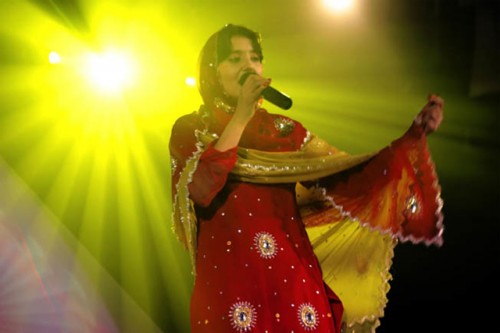Afghan Star
A Show Worth Watching

By Robert Patrick
American Idol has been the staple of popular reality television. And with the floodgates ripping open with howling fans and equal parts monetary gain, there is no reason to expect the series to peter off, even in its umpteenth season on the air. The show’s sheen is blinding, as an array of lights strobe across the sleek stage. The hosts of the show gab to each other, slinging criticism with crooked smiles, all while they swivel in their plush chairs. Everything about the show rages with color, shrill teenage excitement, and blatant advertising ploys that generally ride on the back of some whopping new Toyota model.
In Afghanistan, they have a similar show, designed with similar anecdotes, and a similar host. The contestants, however, aren’t bubblegum chewing kids who shop at the Banana Republic for brand new fedora hats; instead of matting their hair down and puffing out their lips, the hopefuls in the American Idol facsimile, entitled Afghan Star, often wear traditional headwear or simple suits. The entire enterprise has taken Afghanistan by storm, as the revered show has planted its flag firmly as the nation’s first televised talent competition. With the 2004 ban on singing lifted, the country’s outspoken inhabitants have used their voices – quite literally in this case – to express themselves artistically. The political undercurrents in the movie, with the primary focus on the nation’s old world traditions sparring with Afghanistan’s more progressive notions of self, creates an interesting tandem of volatile and virile behavior.
A handful of anxious finalists catch Havana Marketing’s socially informative spotlight in Afghan Star. The melting pot of ethnicities, each expounding upon their distinct interpretations of culture and fame, take front seat as the competition reaches its final weeks. Two women have been cherry picked by the masses to represent the country’s best singers, as well as a few men from areas such as Kabul, Mazar-e-sharif and Herat. The end result is a whirlwind of eager grins, temperamental breakdowns, and your garden variety of death threats – one man suggests that a woman contestant, who danced during a live telecast, should be killed for her misdeed.
The young participants in the documentary are the most interesting people; even more so than the chain of command behind the show at Tolo, the television station that runs the glitter-wound extravaganza. Everything about the program seems mawkish and mechanical, from the gussied up host to the unvarying dramatics during the show’s climactic vote sequences. Afghanistan’s version of American Idol is reminiscent of Slumdog Millionaire’s achingly bright studio, pushy camerawork, and foppish emcee. Havana Marketing’s documentary, however, is less emotionally contrived than the injured doe of a film that won best picture last year at the Oscars. There is a lot of unbridled truth that is captured during some of the film’s best confessionals. The youthful participants in the reality show have as much rebellion and passion as the young adults of America, only with problems that supersede the usual western pockmarks of being unpopular. Have a computer? Don’t worry, the Taliban will plough through your door with the butt of a rifle to snag it from you. The world in Afghanistan is a tough place to be a liberal child, and these contestants push the boundaries to become free of creative oppression.
Afghan Star is a film that most theatergoers wont be, how do I say, initially thrilled about. The premise seems to be no more than a hackneyed publicity stunt for the impressionistic teens who love American Idol – even in other countries. But the film, in actuality, astutely gazes in the direction of change in a country that has been marred by instability. “In Afghanistan, if we don’t have war, we have earthquakes,” says one television producer, his smile dimming by the reality of his comment.
The budget in which Afghan Star was filmed is small. The subject matter is optimistic if not a little boring for large audiences. And the music, strange and exotic as the locations in the film, can seem a bit unnerving upon an untrained ear – and I am truly an untrained ear. With all of this said, the documentary is a great look into the horizon of a changing nation. If you have any interest in current affairs, the cultural crosshatching of music, or inspired filmmaking, you may want to drop a few dollars on Afghan Star.
3/5
Now playing at Landmark’s Ken Cinema
